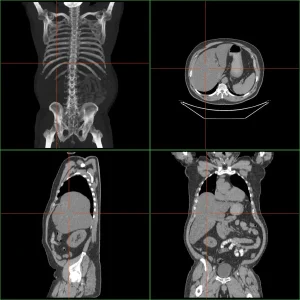
Enlarged Liver
The liver is the largest gland in the human body and is responsible for:
Producing bile, a substance that helps with food digestion
Filtering toxins from the blood, such as medications, alcohol, and drugs
Regulating fat storage, as well as the production and release of cholesterol
Producing hormones and other substances essential for the body’s functioning
Liver enlargement can be caused by liver disorders and may be related to rare diseases such as Gaucher, Pompe, Amyloidosis, and others
What is hepatomegaly?
Liver enlargement is not considered a disease in itself, but rather a sign that something is wrong.
Depending on the underlying cause, an enlarged liver can lead to liver failure and cause serious damage to the body.
An enlarged liver causes pain, pricking and distension, most often in the right hypochondrium and in the median line of the body, in the epigastrium or in the mesogastrium. The most common cause of hepatomegaly is inflammation (by hepatitis A, B or C viruses), steatosis or liver cancer (e.g. hepatocellular carcinoma, secondary tumours/ metastases to the liver, myelofibrosis, leukaemias).
Other local causes of liver enlargement include abscesses, cysts, hepatic hemangiomas, hepatic venous thrombosis (Budd-Chiari Syndrome), biliary tract disease, Wilson disease, fibrosis and cirrhosis, toxic damage to the liver cell (e.g. drug-induced – e.g. oral contraceptives, post-alcoholic), non-alcoholic steatohepatitis (NASH), autoimmune hepatitis.
Other systemic diseases with liver enlargement include storage diseases (e.g. Glycogenosis, Pompe Disease, Gaucher Disease, Amyloidosis, Haemochromatosis), diabetes, metabolic syndrome, heart failure, Crohn’s disease, sarcoidosis, infections (e.g. infectious mononucleosis), myeloproliferative syndromes, hypercoagulable states.
Symptoms of enlarged liver
Liver enlargement can cause pain and sharp sensations in the lower right back area, the upper middle region of the abdomen, or the mediastinum — the space behind the breastbone between the lungs.
In addition, people with an enlarged liver may also experience:
- A feeling of tension or pressure around the back ribs
- Belching
- Flatulence
- Fatigue
- General discomfort
- Pale skin
- Fever
- Headache
- Itchy skin
- Joint pain
- Hair loss
- Yellowing of the skin (jaundice)
- Pale urine and stools
Depending on the underlying cause of hepatomegaly, biochemical test results may show:
- Elevated liver enzymes: alanine aminotransferase (ALT) and/or aspartate aminotransferase (AST)
- Increased serum bilirubin
- Elevated alkaline phosphatase (ALP) activity
- Elevated gamma-glutamyl transferase (GGT) activity
- Coagulation disorders
How to know if you have enlarged liver
In addition to symptoms, physical exams and imaging studies such as ultrasound (US), computed tomography (CT), or magnetic resonance imaging (MRI), as well as angiography, are used to diagnose hepatomegaly.
A liver biopsy can also be performed, usually guided by ultrasound or CT, allowing for microscopic evaluation of the damaged tissue.
Treatment options
Hepatomegaly is treatable, and its management depends on the underlying cause, focusing on addressing the root disease and controlling liver failure.
Treatment may include:
- Hepatoprotective medications
- A liver-friendly diet
- Surgery
- Liver transplant
- Chemotherapy
- Palliative therapies for untreatable cancers
Since the liver plays a vital role in the body’s overall function, identifying the primary cause of hepatomegaly is essential to receive the appropriate treatment.